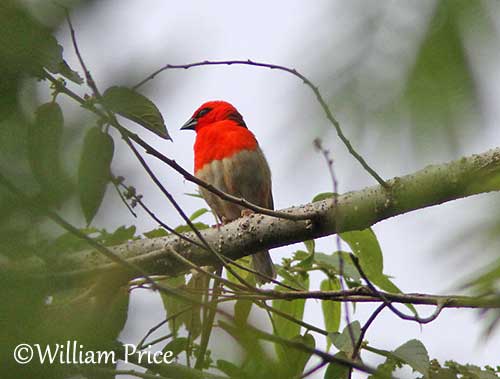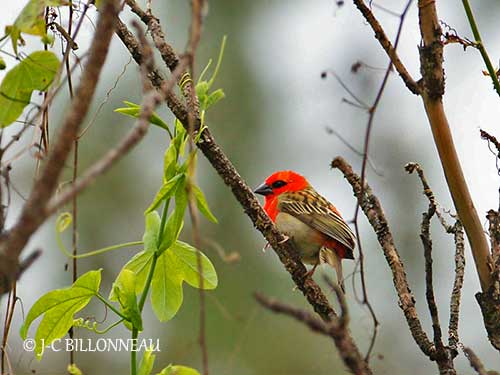
Fr: Foudi de forêt
Ang: Forest Fodi
All: Rothschildweber
Esp: Fodi Forestal
Ita: Fody di foresta
Nd: Rode Boswever
Sd: skogsfody
Mal: droadroaka, Fodiala
Photographers:
John Anderson
John Anderson Photo Galleries
Jean-Claude Billonneau
Photographe-témoin de la Beauté du Monde
William Price
PBase-tereksandpiper & Flickr William Price
Text by Nicole Bouglouan
Sources:
HANDBOOK OF THE BIRDS OF THE WORLD Vol 15 by Josep del Hoyo-Andrew Elliot-David Christie - Lynx Edicions – ISBN: 9788496553682
Birds of Madagascar and the Indian Ocean Islands Par Roger Safford, Adrian Skerrett, Frank Hawkins – ISBN: 1472924118, 9781472924117- Editeur: Bloomsbury Publishing, 2015
Birds of Madagascar: A Photographic Guide Par Pete Morris, Frank Hawkins – ISBN: 0300077556, 9780300077551- Editeur: Yale University Press, 1998
Birds of the Indian Ocean Islands Par Ian Sinclair, Olivier Langrand - ISBN: 1868729567, 9781868729562- Editeur: Struik, 2003
The Birds of Africa: Volume VIII: The Malagasy Region: Madagascar, Seychelles, Comoros, Mascarenes - Par Roger Safford, Frank Hawkins – ISBN: 1408190494, 9781408190494- Editeur: A&C Black, 2013
Family Ploceidae
Page Order Passeriformes
Forest Fody
Foudia omissa
Passériformes Order – Ploceidae Family
INTRODUCTION:
The Forest Fody is endemic to Madagascar where it is restricted to the primary rainforest in the east of the island.
It is very similar to the Red Fody and both species sometimes hybridize involving birds showing intermediate physical characters.
It feeds mainly on insects and seeds, but it also takes nectar from flowers. It often joins mixed-species flocks, but it is usually seen alone or in pairs.
The Forest Fody is fairly common and currently not globally threatened.
DESCRIPTION OF THE BIRD:
Biometrics:
Length: 14 cm
Weight: 15-24 g
The Forest Fody is a small, plump bird. The adult male in breeding plumage has red head, chin, throat, upper breast, rump and uppertail-coverts. Mantle and back are olive-brown with dark central streaks. Some feathers may have red tips. Upperwing and tail are dark olive-green, with yellow edges on flight-feathers and pale edges on wing-coverts.
On rest of underparts, lower breast, belly, flanks, thighs and undertail-coverts are olive-grey with often yellowish tinge on thighs and undertail-coverts.
On the red head, there is a black ring around the eye and a black spot behind the eye.
The bill is black. The eyes are dark brown. Legs and feet are brown.

Female and non-breeding male are similar. Mantle and back are olive-green with central streaks, but the rump is unstreaked. Wings and tail are dark olive-green.
Throat and underparts are olive-grey with faint yellow streaking, but chin and centre of belly are paler.
The head is olive-green with narrow central streaks. Cheeks and ear-coverts are olive-green.
The bill is horn-coloured. The eyes are dark brown. Legs and feet are pale brown.
The juvenile is similar to non-breeding adults, but it has washed brown upperparts and buffy edges to wing-coverts.
RANGE:
The Forest Fody is found in E Madagascar, from Montagne d’Ambre and Tsaratanana, S to Tolagnaro.
HABITAT:
The Forest Fody frequents the evergreen humid forest. It can be found in all forest types from littoral and lowland rainforest to montane forest, and locally in montane bushland and thickets. It may frequent adjacent ricefields and slash-and-burn clearings where it joins flocks of Red Fodies.
The species occurs from sea-level to 2,000 metres of elevation, but it is most common between 1,200 and 1,500 metres.
CALLS AND SONGS: SOUNDS BY XENO-CANTO
The Forest Fody’s song is similar to Red Fody but it is faster and higher-pitched. It is a very high twittering lasting between 20 and 60 seconds “tsisisisisisisistisisititit… tsit tsit tsit tsit tsit tsit tsit… tsertsertser… tsisisisisisititisisisisisititit…” and variants.
BEHAVIOUR IN THE WILD:
The Forest Fody feeds on insects and seeds, and nectar from flowering trees.
It forages alone, in pairs or in mixed-species flocks of up to 100 individuals. It searches for invertebrates through tree-tops and upper to middle levels. While foraging on a branch, it looks alternately under one side and then the other. The flocks feed in and around clusters of large trees, eating both flowers and fruits.
They probably roost in flocks, at least outside breeding season. Some observations describe the flocks singing, calling and flying around, displaying and calling together, considered probably a pre-roost behaviour.
The breeding behaviour in unknown, but it is probably similar to Red Fody.
The Forest Fody is apparently resident on the island.
The flight is fast and direct.
REPRODUCTION OF THIS SPECIES:
Birds can be seen in breeding conditions in January. The pair-formation occurs between November and April. Males are vocally active and develop the breeding plumage during this period.
From an observation, several nests were located around cultivated area and about 400 metres from a ricefield. The nesting sites where in spiny bushes and inaccessible for observation.
However, some behaviour has been described. The male does not take part in the incubation. A male was recorded starting to build a new nest, and it was with a new female while its first mate was incubating.
More information is required.
PROTECTION / THREATS / STATUS:
The Forest Fody is fairly common throughout the restricted eastern forest habitat.
The species could be affected by hybridization with the Red Fody, due to forest fragmentation involving overlap of the respective breeding ranges.
The population is suspected to be declining due to forest destruction and hybridization.
However, the Forest Fody is not globally threatened and currently evaluated as Least Concern.
